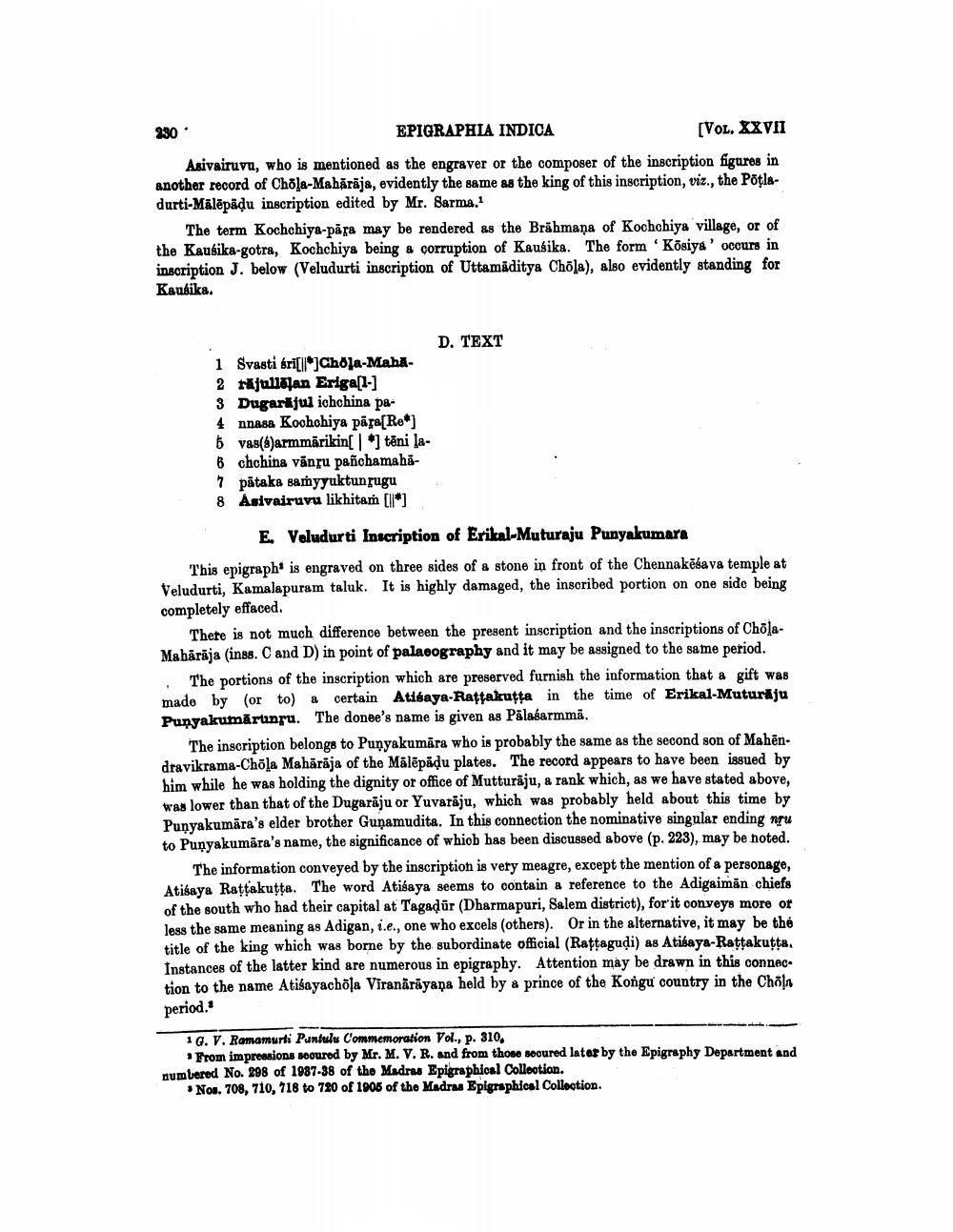________________
EPIGRAPHIA INDICA
[VOL. XXVII
Asivairuvu, who is mentioned as the engraver or the composer of the inscription figures in another record of Chola-Mahārāja, evidently the same as the king of this inscription, viz., the Pōṭladurti-Mālēpādu inscription edited by Mr. Sarma.1
230⚫
The term Kochchiya-para may be rendered as the Brahmana of Kochchiya village, or of the Kausika-gotra, Kochchiya being a corruption of Kausika. The form 'Kōsiya' occurs in inscription J. below (Veludurti inscription of Uttamaditya Chōla), also evidently standing for Kausika.
1 Svasti śri[*]Chōja-Mahā
2
julijan Eriga[1]
3 Dugarajul ichchina pa
4 nnasa Kochchiya para[Re*]
5 van(6)armmarikin[*] těmi Ja
6 chchina vanru pañchamaha
7 pātaka sayyuktanruga
8 Asivairuvu likhitam [*]
D. TEXT
E. Veludurti Inscription of Erikal-Muturaju Punyakumara
This epigraph is engraved on three sides of a stone in front of the Chennakesava temple at Veludurti, Kamalapuram taluk. It is highly damaged, the inscribed portion on one side being completely effaced.
There is not much difference between the present inscription and the inscriptions of ChōlaMahārāja (inss. C and D) in point of palaeography and it may be assigned to the same period.
The portions of the inscription which are preserved furnish the information that a gift was made by (or to) a certain Atisaya-Rattakutta in the time of Erikal-Muturāju Punyakumarunru. The donee's name is given as Palaśarmmā.
The inscription belongs to Punyakumara who is probably the same as the second son of Mahendravikrama-Chōla Maharaja of the Mālēpādu plates. The record appears to have been issued by him while he was holding the dignity or office of Mutturaju, a rank which, as we have stated above, was lower than that of the Dugaraju or Yuvaraju, which was probably held about this time by Punyakumara's elder brother Gunamudita. In this connection the nominative singular ending nṛu to Punyakumara's name, the significance of which has been discussed above (p. 223), may be noted.
The information conveyed by the inscription is very meagre, except the mention of a personage, Atisaya Raṭṭakuṭṭa. The word Atisaya seems to contain a reference to the Adigaiman chiefs of the south who had their capital at Tagadür (Dharmapuri, Salem district), for it conveys more or less the same meaning as Adigan, i.e., one who excels (others). Or in the alternative, it may be thé title of the king which was borne by the subordinate official (Raṭṭagudi) as Atisaya-Raṭṭakutta. Instances of the latter kind are numerous in epigraphy. Attention may be drawn in this connec tion to the name Atisayachōla Viranarayana held by a prince of the Kongu country in the Chola period.
1 G. V. Ramamurti Puntulu Commemoration Vol., p. 310,
From impressions secured by Mr. M. V. R. and from those secured later by the Epigraphy Department and numbered No. 298 of 1987-38 of the Madras Epigraphical Collection.
Nos. 708, 710, 718 to 720 of 1905 of the Madras Epigraphical Collection.




